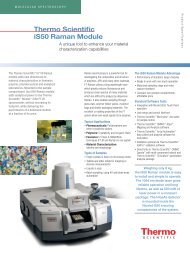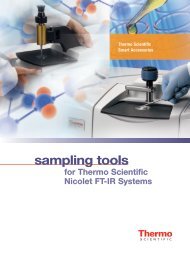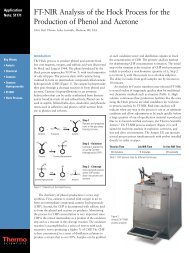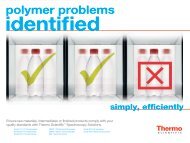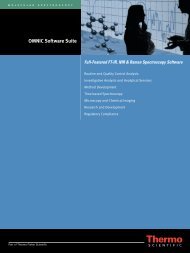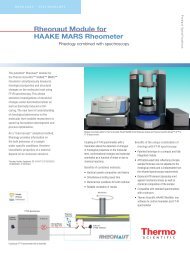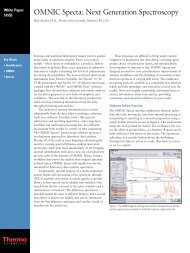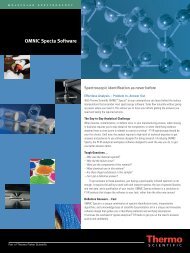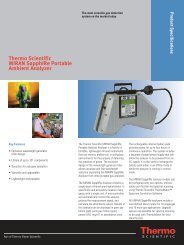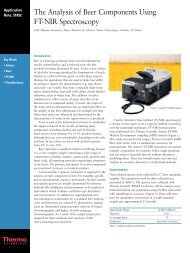Introduction to Fourier Transform Infrared ... - Nicolet CZ sro
Introduction to Fourier Transform Infrared ... - Nicolet CZ sro
Introduction to Fourier Transform Infrared ... - Nicolet CZ sro
You also want an ePaper? Increase the reach of your titles
YUMPU automatically turns print PDFs into web optimized ePapers that Google loves.
molecular spectroscopy<strong>Introduction</strong> <strong>to</strong><strong>Fourier</strong> <strong>Transform</strong><strong>Infrared</strong> SpectroscopyAnalyze • Detect• Measure • Control
<strong>Introduction</strong>What is FT-IR?FT-IR stands for <strong>Fourier</strong> <strong>Transform</strong> InfraRed, the preferred method of infrared spectroscopy. Ininfrared spectroscopy, IR radiation is passed through a sample. Some of the infrared radiationis absorbed by the sample and some of it is passed through (transmitted). The resultingspectrum represents themolecular absorption andtransmission, creating amolecular fingerprint of thesample. Like a fingerprintno two unique molecularstructures produce thesame infrared spectrum.This makes infrared spectroscopyuseful for severaltypes of analysis.So, what information can FT-IR provide?• It can identify unknown materials• It can determine the quality or consistency of a sample• It can determine the amount of components in a mixtureThis booklet is an introduction <strong>to</strong> the concepts behind FT-IR spectroscopy. It covers both thebasic theory of FT-IR and how it works as well as discussing some the practical aspects ofFT-IR use. We hope that it gives you a good understanding of the importance and usefulnessof this powerful technique.2
Theory of FT-IRWhy <strong>Infrared</strong> Spectroscopy?<strong>Infrared</strong> spectroscopy has been a workhorse technique for materials analysis in the labora<strong>to</strong>ryfor over seventy years. An infrared spectrum represents a fingerprint of a sample withabsorption peaks which correspond <strong>to</strong> the frequencies of vibrations between the bonds of thea<strong>to</strong>ms making up the material. Because each different material is a unique combination ofa<strong>to</strong>ms, no two compounds produce the exact same infrared spectrum. Therefore, infraredspectroscopy can result in a positive identification (qualitative analysis) of every differentkind of material. In addition, the size of the peaks in the spectrum is a direct indication of theamount of material present. With modern software algorithms, infrared is an excellent <strong>to</strong>olfor quantitative analysis.Older TechnologyThe original infrared instruments were of the dispersive type. These instruments separatedthe individual frequencies of energy emitted from the infrared source. This was accomplishedby the use of a prism or grating. An infrared prism works exactly the same as a visible prismwhich separates visible light in<strong>to</strong> its colors (frequencies). A grating is a more moderndispersive element which better separates the frequencies of infrared energy. The detec<strong>to</strong>rmeasures the amount of energy at each frequency which has passed through the sample.This results in a spectrum which is a plot of intensity vs. frequency.<strong>Fourier</strong> transform infrared spectroscopy is preferred over dispersive or filter methods ofinfrared spectral analysis for several reasons:• It is a non-destructive technique• It provides a precise measurement method which requires no external calibration• It can increase speed, collecting a scan every second• It can increase sensitivity – one second scans can be co-added <strong>to</strong>gether <strong>to</strong> ratioout random noise• It has greater optical throughput• It is mechanically simple with only one moving part3
Why FT-IR?<strong>Fourier</strong> <strong>Transform</strong> <strong>Infrared</strong> (FT-IR) spectrometry was developed in order <strong>to</strong> overcome the limitationsencountered with dispersive instruments. The main difficulty was the slow scanning process.A method for measuring all of the infrared frequencies simultaneously, rather than individually,was needed. A solution was developed which employed a very simple optical device called aninterferometer. The interferometer produces a unique type of signal which has all of theinfrared frequencies “encoded” in<strong>to</strong> it. The signal can be measured very quickly, usually onthe order of one second or so. Thus, the time element per sample is reduced <strong>to</strong> a matter of afew seconds rather than several minutes.Most interferometers employ a beamsplitterwhich takes the incoming infrared beam anddivides it in<strong>to</strong> two optical beams. One beamreflects off of a flat mirror which is fixed in place.The other beam reflects off of a flat mirror whichis on a mechanism which allows this mirror <strong>to</strong>move a very short distance (typically a fewmillimeters) away from the beamsplitter. Thetwo beams reflect off of their respective mirrors and are recombined when they meet back atthe beamsplitter. Because the path that one beam travels is a fixed length and the other isconstantly changing as its mirror moves, the signal which exits the interferometer is theresult of these two beams “interfering” with each other. The resulting signal is called aninterferogram which has the unique property that every data point (a function of the movingmirror position) which makes up the signal has information about every infrared frequencywhich comes from the source.This means that as the interferogram is measured, all frequencies are being measuredsimultaneously. Thus, the use of the interferometer results in extremely fast measurements.Because the analyst requires a frequency spectrum (a plot of the intensity at eachindividual frequency) in order <strong>to</strong> make an identification, the measured interferogram signalcan not be interpreted directly. A means of “decoding” the individual frequencies is required.This can be accomplished via a well-known mathematical technique called the <strong>Fourier</strong>transformation. This transformation is performed by the computer which then presents theuser with the desired spectral information for analysis.90 Polystyrene run as film807060FFTCalculations50% T 403020InterferogramsCPU1004000 3500 3000 2500 2000 1500 1000 500Wavenumbers (cm-1)Spectrum4
The Sample Analysis ProcessThe normal instrumental process is as follows:1. The Source: <strong>Infrared</strong> energy is emitted from a glowing black-body source. This beampasses through an aperture which controls the amount of energy presented <strong>to</strong> the sample(and, ultimately, <strong>to</strong> the detec<strong>to</strong>r).2. The Interferometer: The beam enters the interferometer where the “spectral encoding”takes place. The resulting interferogram signal then exits the interferometer.3. The Laser: The Laser beam also passes through the interferometer. It is used for wavelengthcalibration, mirror position control and data collection triggering of the spectrometer4. The Sample: The beam enters the sample compartment where it is transmitted through orreflected off of the surface of the sample, depending on the type of analysis beingaccomplished. This is where specific frequencies of energy, which are uniquely characteristicof the sample, are absorbed.5. The Detec<strong>to</strong>r: The beam finally passes <strong>to</strong> the detec<strong>to</strong>r for final measurement. Thedetec<strong>to</strong>rs used are specially designed <strong>to</strong> measure the special interferogram signal.6. The Computer: The measured signal is digitized and sent <strong>to</strong> the computer where the<strong>Fourier</strong> transformation takes place. The final infrared spectrum is then presented <strong>to</strong> theuser for interpretation and any further manipulation.Spectrometer1. Source 2. Interferometer90 Polystyrene run as film80706050% T 403. Sample30201004000 3500 3000 2500 2000 1500 1000 500Wavenumbers (cm-1)4. Detec<strong>to</strong>rInterferogramFFT5. ComputerSpectrumBecause there needs <strong>to</strong> be a relative scale for the absorption intensity, a backgroundspectrum must also be measured. This is normally a measurement with no sample in thebeam. This can be compared <strong>to</strong> the measurement with the sample in the beam <strong>to</strong> determinethe “percent transmittance.” This technique results in a spectrum which has all of theinstrumental characteristics removed. Thus, all spectral features which are present are strictlydue <strong>to</strong> the sample. A single background measurement can be used for many samplemeasurements because this spectrum is characteristic of the instrument itself.5
6A Simple Spectrometer Layout
Advantages of FT-IRSome of the major advantages of FT-IR over the dispersive technique include:• Speed: Because all of the frequencies are measured simultaneously, most measurementsby FT-IR are made in a matter of seconds rather than several minutes. This is sometimesreferred <strong>to</strong> as the Felgett Advantage.• Sensitivity: Sensitivity is dramatically improved with FT-IR for many reasons. The detec<strong>to</strong>rsemployed are much more sensitive, the optical throughput is much higher (referred <strong>to</strong> asthe Jacquinot Advantage) which results in much lower noise levels, and the fast scansenable the coaddition of several scans in order <strong>to</strong> reduce the random measurement noise<strong>to</strong> any desired level (referred <strong>to</strong> as signal averaging).• Mechanical Simplicity: The moving mirror in the interferometer is the only continuouslymoving part in the instrument. Thus, there is very little possibility of mechanical breakdown.• Internally Calibrated: These instruments employ a HeNe laser as an internal wavelengthcalibration standard (referred <strong>to</strong> as the Connes Advantage). These instruments areself-calibrating and never need <strong>to</strong> be calibrated by the user.These advantages, along with several others, make measurements made by FT-IR extremelyaccurate and reproducible. Thus, it a very reliable technique for positive identification ofvirtually any sample. The sensitivity benefits enable identification of even the smallest ofcontaminants. This makes FT-IR an invaluable <strong>to</strong>ol for quality control or quality assuranceapplications whether it be batch-<strong>to</strong>-batch comparisons <strong>to</strong> quality standards or analysis of anunknown contaminant. In addition, the sensitivity and accuracy of FT-IR detec<strong>to</strong>rs, along witha wide variety of software algorithms, have dramatically increased the practical use ofinfrared for quantitative analysis. Quantitative methods can be easily developed andcalibrated and can be incorporated in<strong>to</strong> simple procedures for routine analysis.Thus, the <strong>Fourier</strong> <strong>Transform</strong> <strong>Infrared</strong> (FT-IR) technique has brought significant practicaladvantages <strong>to</strong> infrared spectroscopy. It has made possible the development of many newsampling techniques which were designed <strong>to</strong> tackle challenging problems which wereimpossible by older technology. It has made the use of infrared analysis virtually limitless.7
Thermo Electron Corporation’sFamily of FT-IR TechnologyThermo Electron Corporation is the worldwide leader in FT-IR instrumentation,delivering powerful solutions <strong>to</strong> scientists since the 1970’s.<strong>Nicolet</strong> Series• Easily upgradeable• Superior optical throughput• High resolution• Multiple spectral ranges• Rapid scanning/fast kinetics<strong>Nicolet</strong> Avatar Series• Easy sampling• Easy purge• Easy interface• Easy identification• Easy presentation<strong>Nicolet</strong> IR Series• Minimal training• Suits basic sampling needs• Flexibility of personal compute (PC)• Compact, easy-<strong>to</strong>-use system<strong>Nicolet</strong> Centaurµs <strong>Infrared</strong> Microscope• Simultaneous view and collect• Flexible ATR• Binocular and video view• Easy <strong>to</strong> use<strong>Nicolet</strong> Continuµm <strong>Infrared</strong> Microscope• Highest infrared resolving power• DIC & fluorescence illumination• Simultaneous view and collect• Dual detec<strong>to</strong>rs• View ATR contact• Full au<strong>to</strong>mationSample Compartment Accessories• Samples as small as 50 µm using ATR• Fibers, pellets, paper, powdered samples• Plug and play design for quick analysisAustralia+61 2 8844 9500Austria+43 1 333 50340Belgium+32 2 482 30 30Canada+1 800 532 4752China+86 10 5850 3588France+33 1 60 92 48 00Germany+49 6103 4080India+91 22 2778 1101Italy+39 02 950 591Japan+81 45 453 9100Netherlands+31 76 587 98 88Scandinavia+46 8 556 468 00South Africa+27 11 570 1840Spain+34 91 657 4930Switzerland+41 61 48784 00UK+44 1442 233555USA+1 800 532 4752www.thermo.comThermo Electron ScientificInstruments LLC., Madison, WIUSA is ISO Certified.©2005 Thermo ElectronCorporation. All rightsreserved. All trademarks arethe property of ThermoElectron Corporation andits subsidiaries.Specifications, terms andpricing are subject <strong>to</strong>change. Not all products areavailable in all countries.Please consult your localsales representative fordetails.BR50555_E 11/05M



